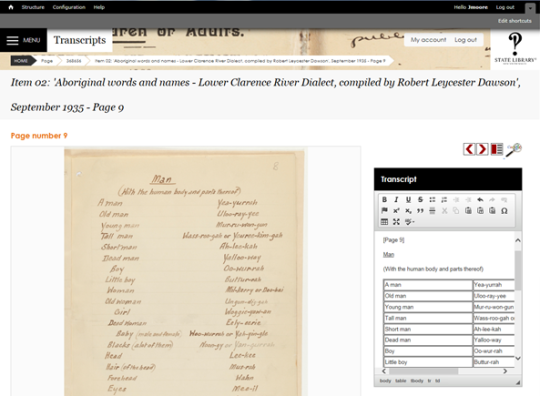Indigenous Languages
Indigenous Languages, Australia’s Intangible Heritage
02/11/2015
Jessica Moore, Intern - Macquarie University
As part of my Cultural Heritage studies at Macquarie University, I undertook an internship at the State Library, which allowed me to work with the Indigenous Services team. Through their Indigenous Languages program, the team collaborates with Indigenous communities in Australia. Establishing relationships with these communities provides a new dimension and richness to the library’s collection material. Furthermore it means that surviving language lists can be made available to Indigenous communities.
During my internship at the State Library the majority of my work involved transcribing various manuscripts, diaries and letters that had been digitised. The collection materials are currently being made available as a trial through the Library’s Rediscovering Indigenous Languages Project. The Transcription Tool allows volunteers to register and get involved in transcribing the digitised collections of the library. Making these items digitally available, provides broader access to the intangible cultural heritage of Australia. It also provides an opportunity for all Australians to gain a better understanding of our nation’s cultural history. As part of my cultural heritage studies and internship experience, I have come to realise the importance of revitalising and preserving endangered Indigenous languages. The collection and preservation of dispersed Indigenous languages reflects Australia’s wider cultural heritage beyond its landscapes and historic buildings.
Prior to European colonisation there were some 250 known Indigenous languages, now only 20 languages are spoken comprehensively. The knowledge of Indigenous practices and much of their ancestral knowledge may have been lost, thus the majority of Indigenous languages come from early written records. The collections within the State Library may be some of the only known surviving records of particular Indigenous languages. Fragments of these languages are embedded within the letters, diaries, journals, and manuscripts recorded by European settlers, naval officers and missionaries. These 18th century vocabulary lists (their meanings) and place names are significant as they provide information regarding the Indigenous language and culture during the time of European contact.
When transcribing these records it is important to consider the educational background and qualification of the recorder, as many of these language lists were written by both amateurs and professionals. We must also speculate the reliability of their informant, and it is for these reasons that the records may not accurately reflect the ways in which the language was spoken amongst Indigenous groups. The Rediscovering Indigenous Languages webpage provides an interactive map that indicates language communities according to states within Australia. This allows individuals to view the spread of languages within Australia, as well as engage with items within the Library’s collection associated with those languages.
Prior to European colonization there were some 250 known Indigenous languages, now only 20 spoken languages remain. The knowledge of Indigenous practices and much of their ancestral knowledge may have been lost, thus a large majority of Indigenous languages come from early written records. The collections within the State Library may be some of the only known surviving records of particular Indigenous languages. Fragments of these languages are embedded within the letters, diaries, journals, and manuscripts recorded by European settlers, naval officers and missionaries. These 18th century vocabulary lists (their meanings) and place names are significant as they provide information regarding the Indigenous language and culture during the time of European contact. When transcribing these records it is important to consider the educational background and qualification of the recorder, as many of these language lists were written by both amateurs and professionals. We must also speculate the reliability of their informant, and it is for these reasons that the records may not accurately reflect the ways in which the language was spoken amongst Indigenous groups.
The Rediscovering Indigenous Languages webpage provides an interactive map that indicates language communities according to states within Australia. This allows individuals to view the spread of languages within Australia, as well as engage with items within the Library’s collection associated with those languages.
Language continues to play an important role in the identity and culture of Indigenous communities, despite the decline of many ancestral languages. Language functions as a vehicle for the passing down of intangible cultural heritage such as oral traditions and practices. By connecting with researchers, educational institutions and community members, the Indigenous Services Team highlights the significance of Indigenous languages as part of Australia’s cultural heritage and history.

http://transcripts.sl.nsw.gov.au/project/Rediscovering%20Indigenous%20Languages
Other links








